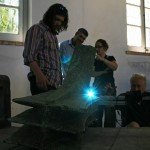Digitally Recording A 3rd Century BC Underwater Battlefield


One of the most exciting archaeological discoveries of the last decade has been an ancient naval battlefield off the Egadi Islands in Italy. Located in over 100 metres depth and requiring robots to survey and record the artefacts, the site dates to the decisive climax of the First Punic War between Rome and Carthage in 241 BC. Previously, only two waterline warship rams had ever been discovered, but ten have been found at the battle site together with thousands of other artefacts. Led by the Soprintendenza del Mare and RPM Nautical Foundation, the discovery is revolutionising what we know about ancient naval warfare.
I have been fortunate to work with the project in recent years and coordinated 3D scanning and elemental analysis of the Egadi 3 ram, as well as several associated artefacts. Dr Chris Begley (Transylvania University), Dr Lawrence Hassebrook (University of Kentucky), Eli Crane (Trioverse), and I scanned artefacts using a structured light scanner. Structured light is a system that often has a higher resolution than laser scanning. A light pattern is projected onto a surface and recorded by a camera, hence the name “structured light.” Much like sunlight coming through Venetian blinds and bending over furniture, the light pattern bends around the target object. Photographs of the bending light are then put into a computer algorithm that calculates the difference between the original design and the one in the photographs, creating a 3D model. Structure light is very common, being used in Kinect game system and by industry for aircraft, military applications, and many other uses.
Elemental analysis was conducted with an Olympus Innov-X DELTA Premium portable x-ray fluorescence (pXRF) spectrometer, kindly provided by Olympus through an Academic Loan Grant. We took over 200 readings on five bronze artefacts. Certain aspects of how ancient bronze was mixed and cast are still debated, so the results were very interesting. The Egadi 3 ram is a leaded bronze (5-12% lead), while the helmets and drinking vessels were more traditional and contained only trace amounts of lead. However, due to seawater leaching copper from the surface layer of the ram, a precise metallurgical characterisation will require intrusive sampling in the future.
As further survey is carried out off the Egadi Islands and more analysis is conducted on artefacts, naval warfare in the ancient world is coming better into focus.
